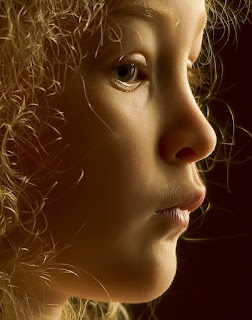to control, but by incorporating diffusers, angles, reflectors and a myriad of other light altering solutions one can effectively control even the harshes of natural light. But what about artificial light? How do you control it? Well, this short article does not provide enough space to dwell on all the exposure variables for using studio or speedlights in the field. But, let us discuss a very simple solution to creating moody light when none is available naturally. What you need is a remotely fired speedlight (off camera flash), a bed sheet, and a large window.
First of all lets briefly discuss how cameras and speedlights work together. It is a common misconception that speedlights are simply used to throw light on your subject. I see this all the time. When you see a photo where the subject(s) appear to be standing in front of a spotlight, well, you get my drift. I have boxes full of them taken with one of those pocket cameras many years ago using the little rotating on camera square flashes...oh my, red eyes and everything. Not much mood inducing effect. Unfortuantely, many novice photographers still believe a high dollar flash unit is simply an expensive way of accomplishing the same thing as those square flash cubes from yester-year. Well...it's not. Speedlights provide the photographer with one of the most powerful mood generating tools in his camera bag. The key is to use it off camera.
Using a speedlight also requires one to expand their understanding of exposure. Anyone who has used a DSLR for any length of time probably knows fundamentally that exposure is controlled by ISO sensitivity, Shutter Speed, and the light gathering Lens Aperture. Some combination of these three creates your image. Change one, and then one or both of the other two has to change to compensate. We'll just leave it at that for now. However, when using a speed light, you must slightly alter your exposure thought process.
All speedlights are designed to provide different Power Settings. But do not be mislead with that concept. First of all, a speedlight always fires at the same intensity on every shot. What changes its Power setting is the amount of time it is allowed to fire, and the actual flash happens very quickly...somewhere in the 1/2000th to 1/3000th of a second range or possibly faster. For example, a full power flash could fire for 1/1000 of a second where a 1/2 power setting will fire for say 1/2000 of a second....these are just round figures and are intended to demonstrate the point, you get the idea. Now think about this. If your camera flash sync speed is say upwards to 1/200th of a second, well compared to 1/2000th of a second, that is pretty slow. What happens is, when your shutter opens the flash fires for that short 1/2000th of a second, and then the shutter closes. (It's more complicated for a high speed sync, slow sync, front/rear curtain sync, but again this is just an example). Your shutter stays open for a relatively long period of time when compared to the flash duration. Knowing this then helps us understand how to use that to our advantage.
In flash photography, the shutter speed controls the ambient light (background light) exposure, while the aperture controls the flash exposure. Uh...what? What this does is to allow the photographer to capture the background ambient light differently than for the light falling on the subject from the flash. If you want to darken the background exposure, set the sync speed to the highest setting your camera will allow. (High speed sync will allow you to fire at a very fast shutter speed and still sync with the camera flash.) Your aperture then is set to capture the light coming from the flash because it fires so quickly, it really doesn't matter so much what your shutter speed is as long as it syncs with the flash...Huh?
Okay...I said this was simple...so let me demonstrate using the sample photo. Notice how the background appears dark, but the subject appears correctly exposed in moody light. The room actually was filled with a good amount of ambient light flowing into it from a large window, but by setting the sync speed to its highest allowed setting (1/200th in this case), and using a low ISO setting (100) that ambient light exposure was subdued to the point the room appeared to be rather dimly lit, when in fact there was a good amount of ambient light flowing into it. The flash unit was set to 1/2 power and positioned about 2 feet away from the window, then fired thru window from the outside. The aperture was set I believe at f/5.6, to properly match the flash output exposure. What you end up with is a subject lit by moody side light against a dark background.
 So, how did I get the moody light from this setup? Simple actually, I taped a bed sheet to the outside of the
So, how did I get the moody light from this setup? Simple actually, I taped a bed sheet to the outside of the window which diffused not only the ambient light, but the speedlight flash as well. It effectively became a very large softbox and spred the concentrated light from the flash to provide a very soft kiss of light that subtly wrapped around my subject who was positioned about 5 feet from the window. I set the camera to a Shady White Balance setting that pushed the white balance into a warmer tone. The result was a moody, warm toned, photograph using controlled light from a flash. This image was captured on one take, one shot.
Moody Light, it is as simple as understanding how your camera and an off camera speedlight work together, being a little creative, and combining the two into an effective solution.


No comments:
Post a Comment